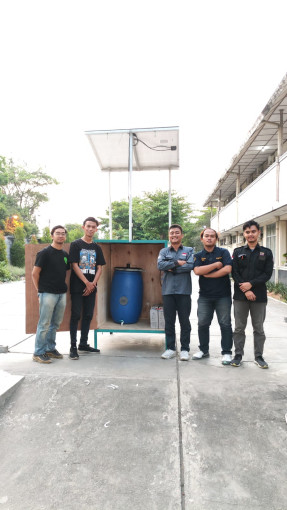
A team of UGM students has successfully developed an automated liquid fertilizer composter integrated with a control system. This device is unique because it utilizes solar energy to reduce the cost of liquid fertilizer production.
“This device was created to express environmental concern, particularly in Yogyakarta. Recently, waste has been accumulating on the streets and tourist sites, exacerbated by the closure of the Piyungan landfill,” explained team leader Rizki Andriansyah on October 20.
The team initiated the development of this device due to the increasing volume of waste in Yogyakarta, which has coincided with a growing population in the city. The closure of the Piyungan landfill has raised concerns about waste disposal among the local community.
“Given this situation, we wanted to provide the community with a solution in the form of liquid fertilizer produced from organic materials, which we believe is more environmentally friendly than chemical fertilizers,” added Andriansyah.
Andriansyah and his four colleagues from the UGM Vocational College, Albarra Ammara Hadi (Heavy Equipment Management and Maintenance Engineering), Fabio Khrisna Mukti (Heavy Equipment Management and Maintenance Engineering), Farras M. Yusa (Soil Science), and Yunus Alif Nur Rahman (Instrumentation and Control Engineering Technology), set out to find a solution by creating an automatic liquid fertilizer composter.
The device was developed under the guidance of Dr. Felixtianus Eko Wismo Winarto, and it was funded by the Ministry of Education and Culture’s Student Creativity Program in Innovative Work in 2023.
This innovation has distinct characteristics and structure compared to conventional composters. It is equipped with additional components to facilitate the composting process.
“This composter is equipped with a mixer connected directly to a motor to aid in composting,” explained Andriansyah.
He revealed that the device was constructed using easily accessible materials, including iron, vinyl-coated plywood, and various electronic components.
Yunus Rahman added that the operational principle of this composter is similar to conventional composters, with differences in the composting process, aided by a mixing blade and water bubbles.
“The operation is similar to other composters, but here, we use an iron mixing blade to help aerate the organic materials inside the drum, ensuring they break down quickly,” he explained.
Additionally, the device is equipped with an air pump to supply oxygen to the drum, which promotes the growth of microorganisms used in the composting process.
Furthermore, Farras Yusa pointed out that one of the advantages of this composter is its ability to produce one liter of liquid fertilizer in less than two days.
“The mixing blade aerates and moistens the organic materials, accelerating the production of liquid fertilizer within a specified volume, quicker than conventional composters,” Yusa elaborated.
Author: The UGM Solar-Powered Composter Team
Editor: Ika

